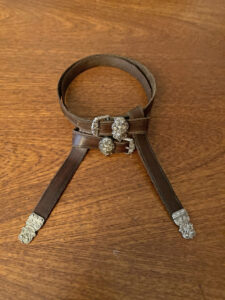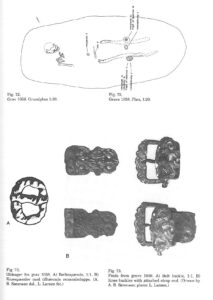LEJRE WICKELBANDER GARTERS
 After finally deciding on a Viking Age impression, that of a mid 950’s shipmaster, I’ve been slowly expanding his visual appearance. As an old guy (silly to represent as someone younger) and having developed a back story (see link here), I’ve been working on the clothing and accessories such a person might have. One such item he might have acquired in his travel are the Lejre wickelbander garters.
After finally deciding on a Viking Age impression, that of a mid 950’s shipmaster, I’ve been slowly expanding his visual appearance. As an old guy (silly to represent as someone younger) and having developed a back story (see link here), I’ve been working on the clothing and accessories such a person might have. One such item he might have acquired in his travel are the Lejre wickelbander garters.
Alrik hails from near the town of Ribe, in what is now modern Denmark. Certainly he would have had access to bits and pieces of clothing accessories from other areas. During his wanderings, before he went a viking, he visited the town of Lejre, on the island of what is now Zealand. He noticed that some wealthy males used a strap concoction to hold up their wickelbanders or leg wraps. These “garters” looked stylish and provided an adjustable amount of support for keeping the leg wraps high and tight. Finding a merchant, he was able to procure a set and therein lies the tail of how they came to be in this modern representation of an old viking shipmaster.
When I first became aware of the Lejre garters, I knew that I wanted to replicate them for my impression. So, finding a picture on the internet, I wrote down my thoughts and sent both to the folks at Armour and Castings in Ukraine, where I had the preponderance of my findings for my belts and sword scabbard and baldric cast. Since they didn’t have this particular item in their inventory, this would be a custom commission casting for me. I waited for a while as they prepared a rendering of the garter findings for me to approve. Once they showed up in my email box, I quickly approved them and asked Armour and Castings to proceed with the sculpting of the wax masters and casting of the final pieces. Since my impression is one of a wealthy higher class individual, I asked that the findings be cast in bronze, and silver plated (confession, I can’t afford this hobby if all my bling was sterling…lol…).
 After what I considered an interminable wait (they were really busy), a package arrived on my doorstep. The garter findings had finally arrived! I eagerly tore open the package and my eyes feasted on it’s contents. Beautifully crafted, they were everything I expected. My next step was to attach some leather to them, to make them usable. Since I had spec’d the garters prior to their being cast, I had all the dimensions I needed to prepare leather straps with a cross section of 5/8″. The strips were cut length-wise to go around my calf, plus fold over and hang down a bit (more about that later). I took some strips of 6-7 oz. vegetable tanned leather and scribed dual lines the length of the strips to give them a slightly more rich appearance than just plain leather. Next, I used my trusty brown antique dye and applied it to both the front, back and edges. After the leather dried, I burnished the edges and applied a finish coat, then buffed the strips to a nice luster. Leather preparation complete, it was attachment time.
After what I considered an interminable wait (they were really busy), a package arrived on my doorstep. The garter findings had finally arrived! I eagerly tore open the package and my eyes feasted on it’s contents. Beautifully crafted, they were everything I expected. My next step was to attach some leather to them, to make them usable. Since I had spec’d the garters prior to their being cast, I had all the dimensions I needed to prepare leather straps with a cross section of 5/8″. The strips were cut length-wise to go around my calf, plus fold over and hang down a bit (more about that later). I took some strips of 6-7 oz. vegetable tanned leather and scribed dual lines the length of the strips to give them a slightly more rich appearance than just plain leather. Next, I used my trusty brown antique dye and applied it to both the front, back and edges. After the leather dried, I burnished the edges and applied a finish coat, then buffed the strips to a nice luster. Leather preparation complete, it was attachment time.
Measuring an appropriate distance, I punched holes for sewing on the belt buckle and further down for the keeper, then I folded over the leather and began stitching with waxed synthetic sinew until completion. Afterwards, I put on my viking Thorsberg trousers and wound my wickelbanders around my calves, then placing my turnshoes on the appropriate feet. Taking up the garter strap, I wound it around my leg, marking holes for the tongue of the buckle. One before and one after the optimum hole, just to give me some leeway. I buckled on the garter, slid the leather through the keeper and folded the leather under and looped it back through, much as one would do with a belt. From that, I was able to determine the optimum length for the hang down. The last step was to install the strap hanger. The first garter was complete and the second soon followed.
I’m quite pleased with the results and am now wearing them in place of the wickelbander hooks. They look pretty spiffy, as befits my status as a well to do shipmaster.
After I had completed the project, I realized the information I had gathered might be good to post on the website, as others could possibly be interested in them, as well.
Here’s what I found out, in terms of archaeological information. I based the garters on those that were found at Lejre, in grave 1058, on the island of Zealand, Denmark. They are dated to the 9th century and the culture, is of course, viking.
The archaeological reference and description reads as follows :
Fixed grave. 2.25 x 1.10 m; depth: 1.4 m. Orienting: O-V.
In the grave fill, some pottery shards were found as well as a little burnt leg. Down through the fullness, coffins were observed tracks, approx. 0.45 m wide.
Remains of a skeleton were found on the burial ground. They are stretched out on their backs with the skull at the west end.
Skeletal Determination: Probably a male, adultus/maturus (25 – 40 years).
Findings:
1a. Bronze buckets, 2.9 x 2.4 cm. rectangular bezel, which is decorated at the front with ribbon meandering in serrated cut. The upper side gilded, the lower side wasted. Remains of a band of bronze tin that has held the strap to the bucket. (C 30138)
1b. Belt slider of bronze, possibly designed as one animal seen from above. 3.2 x 2.0 cm. Top side gilded, the under side partially anointed. (C 30138)
1c. Fragment of charging strap with holes for the thorn: approx. 10.5 cm long, 2 cm wide and 1.5 mm thick. (C30138)
 2. Strap fitting of bronze, shaped like one male mask seen en face. 3.5 x 1.9 cm. Home gilt, reverse sunlit. Remains of leather strap fixed with three bronze rivets. (C 30139)
2. Strap fitting of bronze, shaped like one male mask seen en face. 3.5 x 1.9 cm. Home gilt, reverse sunlit. Remains of leather strap fixed with three bronze rivets. (C 30139)
3a. Strap buckle and strap slider of bronze attached to remains of the strap with the help of a bronze band. Shape and decoration exactly like C 30138, only with few differences in the design of the belt slider, the animal’s hairstyle and shoulders. (C 30140)
3b. Fragment of charger strap; width: 2.1 cm, preserved length: 5.7 cm. (C 30140)
4. Strap fitting of bronze, completely similar to C30139, but without gilding on the front. 3.4 x 1.9 cm. Backside faded. Remnants of charging strap (3.4 x 1.9 x 0.3 cm) attached with three bronze rivets. (C 30141)
5. Oval belt buckle made of iron. 3.4 x 2.8 cm. (C30142)
6. Iron knife, length: 17 cm. Tip broken off. Curved back with sloping transition to handle tip. (C30143 At the hill section there were 5. 0g 6. (belt buckets 0g knife). A little below where the right knee is supposed to be to have been, 1a 1. and 2. (belt buckle, belt slider 0g strap attachment). Corresponding to 1a 3. 0g 4. little below the left knee. The excavation clearly showed, that the two buckles with matching leather straps and end fittings have been tied around the dead man’s legs, so that the bucket and the belt slider are still on the outside of the leg. At the right set one could observe traces of rope are taken between the end bracket and the highly dissolved bone mass.
SPECIAL NOTE: In addition to the archaeological reference and bibliography below, I am indebted to three other individuals who share my passion for the historical reenactment of the Viking Era. I must acknowledge their contributions in pointing me to exactly the right information and associated illustrations/photographs that were used in the construction of this page. A big thank you to Gabe Martin of Timberhavn Vikings, especially to David Stříbrný of Marobud & sagy.vikingove.cz and Khalja Khorkhoi.
_____________________________________________________________________________
Bibliography and Reference
Andersen, S. W., 1995: Lejre – skibssætninger, vikingegrave, Grydehøj. Aarbøger for Nordisk Oldkyndighed og Historie, 1993, 7-137.
“World of the Vikings” (1994). CD-ROM for Apple Macintosh, Version 1.1. Past Forward Ltd: York.
Beatson, Peter – NVG Miklagard, “Wickelbanders”, http://members.ozemail.com.au/~chrisandpeter/Legwraps/Articles/legwraps3.htm








